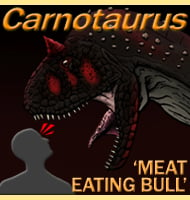In Depth
With three pairs of short blunt horns on top its skull and two tusks that pointed down from the upper jaw, Eobasileus looked remarkably similar to its close relative Uintatherium (which is why unsurprisingly it is a member of the Uintatheriidae). With an upper size comparable to that of a large black rhinoceros (Diceros bicornis), Eobasileus was one of the largest animals in its habitat and when fully grown and probably did not have to worry too much about being attacked by the much smaller creodont predators of the time.
Further Reading
- Notices of New Vertebrata from the Upper Waters of Bitter Creek, Wyoming Territory. – Proceedings of the American Philosophical Society 12(86):483-486. – E. D. Cope – 1872. – Revision of the Uintatheres. – Bulletin of the Peabody Museum of Natural History. Bulletin 14: 5. – Walter H. Wheeler – 1961.









